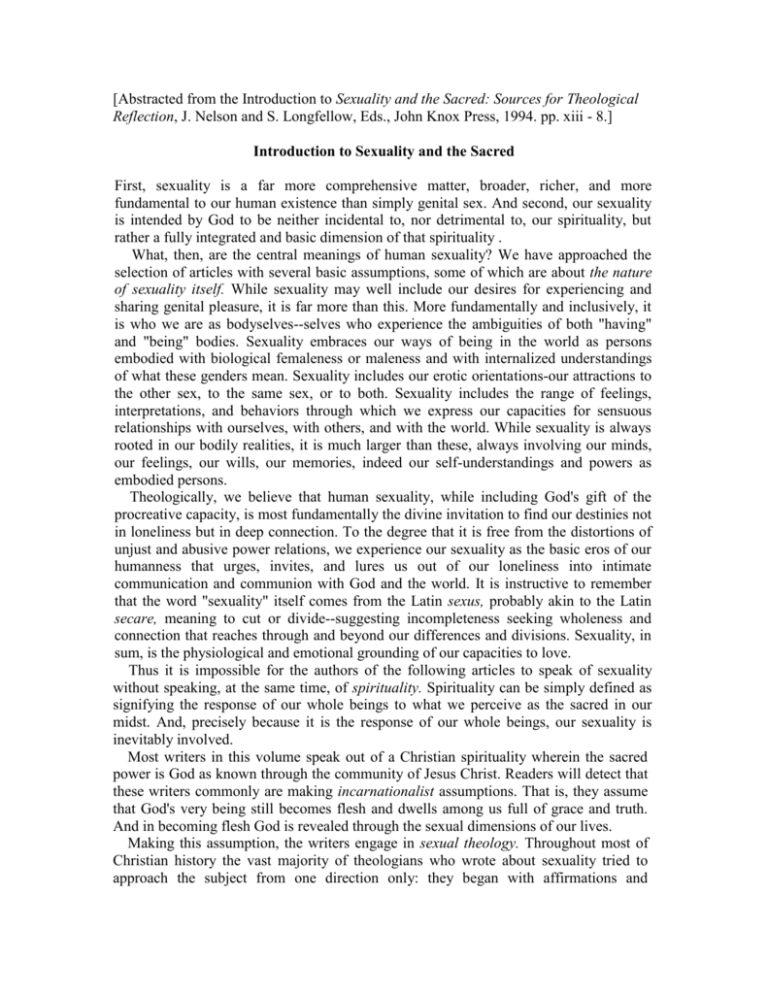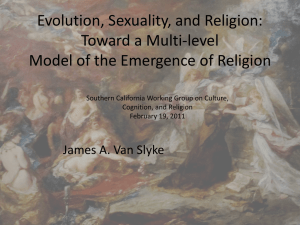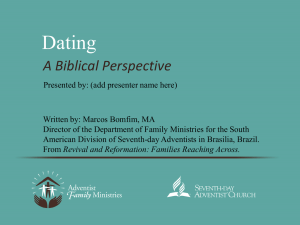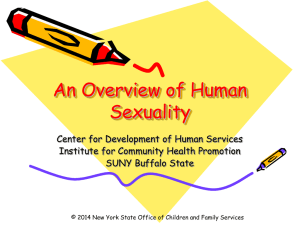
[Abstracted from the Introduction to Sexuality and the Sacred: Sources for Theological
Reflection, J. Nelson and S. Longfellow, Eds., John Knox Press, 1994. pp. xiii - 8.]
Introduction to Sexuality and the Sacred
First, sexuality is a far more comprehensive matter, broader, richer, and more
fundamental to our human existence than simply genital sex. And second, our sexuality
is intended by God to be neither incidental to, nor detrimental to, our spirituality, but
rather a fully integrated and basic dimension of that spirituality .
What, then, are the central meanings of human sexuality? We have approached the
selection of articles with several basic assumptions, some of which are about the nature
of sexuality itself. While sexuality may well include our desires for experiencing and
sharing genital pleasure, it is far more than this. More fundamentally and inclusively, it
is who we are as bodyselves--selves who experience the ambiguities of both "having"
and "being" bodies. Sexuality embraces our ways of being in the world as persons
embodied with biological femaleness or maleness and with internalized understandings
of what these genders mean. Sexuality includes our erotic orientations-our attractions to
the other sex, to the same sex, or to both. Sexuality includes the range of feelings,
interpretations, and behaviors through which we express our capacities for sensuous
relationships with ourselves, with others, and with the world. While sexuality is always
rooted in our bodily realities, it is much larger than these, always involving our minds,
our feelings, our wills, our memories, indeed our self-understandings and powers as
embodied persons.
Theologically, we believe that human sexuality, while including God's gift of the
procreative capacity, is most fundamentally the divine invitation to find our destinies not
in loneliness but in deep connection. To the degree that it is free from the distortions of
unjust and abusive power relations, we experience our sexuality as the basic eros of our
humanness that urges, invites, and lures us out of our loneliness into intimate
communication and communion with God and the world. It is instructive to remember
that the word "sexuality" itself comes from the Latin sexus, probably akin to the Latin
secare, meaning to cut or divide--suggesting incompleteness seeking wholeness and
connection that reaches through and beyond our differences and divisions. Sexuality, in
sum, is the physiological and emotional grounding of our capacities to love.
Thus it is impossible for the authors of the following articles to speak of sexuality
without speaking, at the same time, of spirituality. Spirituality can be simply defined as
signifying the response of our whole beings to what we perceive as the sacred in our
midst. And, precisely because it is the response of our whole beings, our sexuality is
inevitably involved.
Most writers in this volume speak out of a Christian spirituality wherein the sacred
power is God as known through the community of Jesus Christ. Readers will detect that
these writers commonly are making incarnationalist assumptions. That is, they assume
that God's very being still becomes flesh and dwells among us full of grace and truth.
And in becoming flesh God is revealed through the sexual dimensions of our lives.
Making this assumption, the writers engage in sexual theology. Throughout most of
Christian history the vast majority of theologians who wrote about sexuality tried to
approach the subject from one direction only: they began with affirmations and
assertions of the faith (from the scriptures, from doctrines, from churchly teachings, and
so on) and then applied those to human sexuality. Now, theologians such as those
included here are assuming that the other direction of inquiry is important as well: What
does our sexual experience reveal about God? about the ways we understand the gospel?
about the ways we read scripture and tradition and attempt to live out the faith?
This means a discovery of the church as a sexual community, another theme common
to these authors. If through most of Christian history the church has understood sexuality
either as incidental to or detrimental to its life, a new understanding has emerged-largely
spurred by feminist theologians and by gay and lesbian theologians. Those oppressed or
discounted because of their sexuality have long known that the church has always been,
among other things a sexual community. It has incorporated "a host of sexual
understandings--for good and for ill--into its language and images, into its worship and
leadership patterns, into its assumptions about power and morality, and into its definitions
of membership. The church has been doing this, often quite unconsciously, while at the
same time believing that it could write and teach about sexuality from a standpoint of
faith quite unaffected by sexual assumptions. Now many of us believe differently.
Recognizing that at the same time the church is a community of faith, worship, and
service it is also a sexual community opens the door to new consciousness of sexual
oppressions and new possibilities for life-giving transformations.
Sexuality is invariably social and public in its implications. The feminist insight that
"the personal is political" marks the insights of the authors included here. When they
speak of "intimacy," for example, they exhibit a common understanding that our
sexuality invites us to intimacy not only with the beloved person but also with all
creation. It is intimacy marked by right relationships, mutual power, and justice in our
social structures.
There are several related topics that we have not covered. One group is that of certain
sexual subjects we deem beyond the scope of this volume, particularly abortion,
contraception, sterilization, and reproductive technologies. Again, space limitations make
it impossible to do justice to the range and complexity of interpretations of these issues.
Moreover, bioethical anthologies on these subjects are readily available elsewhere.
Secondly, we had wished to include certain important subjects, but we were disappointed
in the dearth of adequate theological treatments of them. These include issues as diverse
as childhood sexuality, bisexuality, and certain sexual variations (for example,
transsexualism and transvestism).
Without any exaggeration, we can safely say that the past decades are without parallel
in the long history of the church in terms of the amount of critical focus on sexuality
issues.
Introduction to Part One
What does our human sexuality mean? That is the larger question addressed
throughout this volume. In this section we focus on two background questions. The first
is this: From whence come those meanings? Are they intrinsic to our sexuality? just
there? implanted by our Creator? On the other hand, do we create those meanings
through our interaction with others? Or, in some sense are both of these things true? The
second question is; this: Regardless of the source of those sexual meanings, what are the
important and appropriate sources for Christians to use in discerning them?
Turning to the first question, the two theories currently vying with each other are
social constructionism and essentialism. Social constructionism emphasizes our active
roles as human agents deeply influenced by our social relations in structuring or
"constructing" our sexual meanings and values. While our capacities to feel and to act
sexually are, of course, rooted in the sexual and bodily realities that are given to us, the
meanings of those feelings and expressions vary greatly over time and among different
cultures. For example, whereas persons in most cultures consider a kiss on the lips to be a
positively charged sexual gesture, some Inuits find such kisses repulsive, and not the least
bit erotic. In another example, traditional native Americans avoid making eye contact
during conversation, a practice that may seem evasive to European Americans. The
Indians, however, regard sustained eye contact as rude and invasive. Thus, the social
constructionists say, we socially attach symbolic meanings to our bodily and sexual
expressions, meanings that are not intrinsically coded into people.
In contrast, the essentialists, or empiricists, emphasize the objectively definable reality
of sexual and bodily meanings. The body, they claim, has its intrinsic and given
meanings, quite apart from whatever we happen to believe about it. Though sexuality
may well be acted out differently in various times and places, there is something
universal and constant about its core reality. For example, the official Roman Catholic
understanding of natural law states that sexual expression has an intrinsically procreative
meaning. Hence, all sexual expressions (such as contraceptive sex, oral sex, anal sex, and
masturbation) that deliberately frustrate the procreative possibility are unnatural-against
the given, essential nature of our human sexuality.
Carter Heyward's essay makes a strong case for social constructionism. She maintains
that "our sexual relations, indeed our sexual feelings, have been shaped by historical
forces--the same contingencies, tensions, politics, movements, and social concerns that
have shaped our cultures, value systems, and daily lives." She argues that a historical
reading of sexuality is an interpretation of power--whether that is power over other
persons or mutually empowering relationships. If we accept the radical relationality and
historicity of who we are as persons, we will not succumb to the belief that our sexuality
is fixed or unchanging. Such a social and historical perspective, she believes, frames our
sexual ethics around issues of what we do rather than what we are.
Lisa Sowle Cahill frames the question with a more essentialist emphasis. The problem,
she says, is that in the unity of our personhood we experience our sexuality as a dualityboth physical and spiritual. Sex is physical, urgent, and pervasive. It is also an avenue for
the deep expression of emotion and spirituality among persons. Our sexuality cannot be
reduced simply to its procreative potential or its physical pleasure, for it is also a
constituent of those relationships that are most distinctively human. Thus, "It is possible
to define at least approximately, some ‘essential’ or ‘ideal’ meaning of sexuality, despite
actual historical distortions or adaptations of it in the human sexual reality, and despite
the limits of the human mind in seeking to discover it." Cahill joins those philosophers
and theologians who wish "to affirm the essential character of sex in relation to human
being, the meaning of sex as expression of interpersonal relation as well as procreation,
and the equal dignity of man and woman."
One way of grasping the difference between these two writers is to ask, What are they
fundamentally worried about? Heyward is concerned that essentialism is often used to
oppress persons (for example, lesbians and gay men) whose sexuality does not conform
to certain notions of a given and unvarying truth of sexuality (for example, procreation).
Cahill, on the other hand, is more concerned that without claiming something essentially
given about sexuality we fall into an utter relativism about its meanings, a relativism
incompatible with Christian faith.
Both authors, we believe, have some truth in their positions. We have chosen to
represent both social constructionists and essentialists throughout this volume, though
with some accent on the former. But the positions need not be seen as polar opposites.
We emphasize constructionism because we believe our sexuality is, indeed, subject to a
vast range of socially constructed meanings, and those meanings are often related to
social power. Hence, we believe that the major focus for our theological and ethical
questions should be on the meanings of our ways of being sexual, not upon the physical
contours of specific acts. Further, if sexual meanings are socially constructed, they can
also be reconstructed in ways that are more just, more whole, more life-giving. By the
same token (and here is the truth of an essentialist emphasis), sexual meanings are not
entirely relative. There is something "given" in our sexuality--not intrinsically embedded
in certain specific acts, but intended by God for our sexual relationship--that our
relationships be those marked by justice, wholeness, and life-giving love.
Turning to the second major question, we ask, With what sources might we work as we
do our sexual theology? Cahill points to four complementary sources for Christians to use
in sorting out the problematic qualities of sex. They are (1) the Bible (the foundational
texts of the community), (2) tradition (the historic teachings, practices, and
understandings of the church), (3) philosophical accounts of essential humanity
(normative accounts of what human beings truly ought to be), and (4) descriptive
accounts of what actually is the case regarding our sexuality. All four of these, she
maintains, are indispensable and, indeed, mutually correcting. Even though it is never a
simple matter, a faithful and judicious balancing of these sources is what we need. A
slightly different way of naming these four ("the Wesleyan quadrilateral") will be illustrated in James B.
Nelson's article on homosexuality in part 5.
The importance of these mutually complementary and mutually correcting sources has
been recognized in various parts of the Christian community, even though some
Christians emphasize one more than the others. Many Protestants have attempted to turn
almost exclusively to the Bible as their authority. L. William Countryman demonstrates
the futility of this approach but also argues that the scriptures are powerfully relevant.
Countryman argues that the Bible's specific sexual norms are largely alien and
irrelevant to us today, for the significant texts dealing with sexual morality were framed
by purity and property systems that we have, with good reason, abandoned. Ancient
purity laws with a particular focus on bodily boundaries dealt with those actions deemed
clean or dirty, pure or impure. Our biblical forebears' main concern in these laws was not
the ethical quality of the sexual acts as such, but what certain bodily acts symbolized
regarding the boundaries of the chosen, holy people. When in the course of time the
gospel message cast into doubt the principle of the purity system, the New Testament
writers still appealed to another principle--property. The patriarchal household, with its
male ownership of women and children, was kept as the building block of the sexual
property system. Thus, adultery, fornication, and incest were defined as violations of
sexual ownership and family lineage.
While those ancient systems of purity and property are no longer appropriate for us,
Countryman argues that there is great scriptural relevance for sexual theology and ethics.
The Bible is important precisely because it is alien to our historical-cultural situation and
therefore relativizes it. The scriptures relativize our sexual norms to make fresh room for
the gospel of God's grace. Further, the Bible shows how the grace of God broke into the
self-sufficiency of another culture, and hence how it can shatter our own self-sufficiency.
Countryman then proposes a set of basic principles along with some "derived guidelines"
to illustrate how the scripture can subject our own sexual patterns and institutions to the
gospel. His essay thus argues for the critical importance of scripture in doing sexual
theology, without claiming that scripture alone is sufficient.
Margaret Farley addresses tradition by noting that "the teachings within the Christian
tradition regarding human sexuality are complex, subject to multiple outside influences,
and expressive of change and development through succeeding generations of
Christians." Careful attention to tradition helps us grasp why and how we have come to
our present positions and confusions about sexuality.
An important illustration of this is Farley's summary of the Gnostic and Stoic
influences. Both Gnosticism and Stoicism were profoundly dualistic in their
understandings of human nature. Both sharply separated spirit from body, with the spirit
believed to be good and eternal while the body was seen as mortal, suspect, and the
particular locus of evil. Gnosticism, however, led to two different extremes-the complete
rejection of sex and the embrace of sexual licentiousness. It was in the Stoic justification
of sexual intercourse for the sole purpose of procreation that early Christians found the
answer to the Gnostics. That justification allowed them to affirm procreation as the
central rationale for sex and still to maintain the spiritual superiority of virginity. With
this, as Farley observes, "the direction of Christian sexual ethics was set for centuries to
come." Though such Stoic reasoning may seem archaic and foreign to modern Christians,
few of us have been untouched by religious suspicions regarding sexuality per se, and by
negative evaluations of those sexual acts that are inherently non-procreative, such as oral
sex, masturbation, and homosexual intercourse. Tradition, indeed, helps us understand
why we are as we are.
This same illustration, however, suggests a second contribution of tradition. Late
Hellenistic dualism as expressed in both Gnosticism and Stoicism did not originate in
Jewish or Christian sources. Yet it profoundly influenced all subsequent Christian
understandings of sexuality. Thus, grasping something of the tradition helps us
comprehend the ways in which sexual theology is never ‘pure,’ but always finds its
shaping in relation to the cultural contexts in which Christians live. Moreover,
understanding of our religious heritage assists us to recognize ways in which the tradition
itself is susceptible not only to modifications but also to fundamental shifts regarding
human sexuality. Farley points out how the shift away from the centrality of the
procreative norm began in the fifteenth century, when certain theologians began to justify
the good of sexual pleasure itself for the well-being of persons. A century later, in the
Protestant Reformation, John Calvin affirmed that "the greatest good of marriage and sex
is the mutual society that is formed between husband and wife." Hence, tradition is
neither monolithic nor unchanging.
The branch of the church that has most strongly emphasized the continuity of tradition
is currently the site of considerable ferment in sexual theology. Many leading Roman
Catholic theologians now defend pluralism on numerous sexuality issues and the
importance of distinguishing between what is central to the faith and what is peripheral.
Charles Curran, for example, writes, "dissent from the authoritative, non-infallible
hierarchical teaching of the Roman Catholic Church is an effort to support, not destroy,
the credibility of the teaching office. The theological community can play the critical role
of the loyal opposition, thus enhancing the church's teaching role.... The primary teacher
in the church remains the Holy Spirit--and no one has a monopoly on the Holy Spirit."
In addition to scripture and tradition, reason and experience are the remaining sources
to which sexual theology turns. These are amply illustrated in many of the selections
throughout the remainder of the book. Reason, as Cahill notes, includes philosophical
accounts of what human beings truly ought to be. We suggest that some elements of
Cahill's fourth source, "descriptive accounts of what actually is the case regarding our
sexuality," might also be included in our understanding of reason. It is, after all, the
disciplined exercise of reason as found in the various sciences concerned with human
sexuality (such as biology, medicine, anthropology, psychology, and sociology) that
attempts to describe "what actually is the case." That these elements of reason--insights
about sexuality from the sciences--are present in most of the selections and interacting
with scripture and tradition will be apparent.
The fourth source is experience. Some would include the sexual work of
psychologists, sociologists, and anthropologists under this rubric, inasmuch as they
attempt to describe the ranges of human sexual experience. Others would say that since
these sciences are attempts to give objective and rational interpretation to sexuality, they
are rightly understood as exercises of reason. Our awareness of and use of the multiple
sources of insight are the critical elements.
But there is one other area of experience crucial for sexual theology, an area only
indirectly addressed by the behavioral sciences. It is our personal and communal
experience as sexual beings. Ever since the rise of theological liberalism in the early
nineteenth century, much of the church has recognized human experience as a valid and
important source of Christian theology. In the latter part of the twentieth century various
forms of liberation theology have boldly named experience as central to the theological
task. In selections throughout this volume we shall see writers drawing heavily on their
own sexual experiences as sources of theological insight--in dialogue with scripture,
tradition, and reason. Often that experience is some form of sexual oppression. Or it is the
experience of sexual intimacy. At other times it is sexual experience particular to female
or to male bodies. Or it is sexual experience in physical disability or in aging. In all cases,
the writers claim that a viable sexual theology cannot omit this realm of God's revelation.
Although we have used a number of labels and categories in this introduction, reality is
not all that neat. Our interpretations of sexual meanings need to be informed by the
positions of and the debates between social constructionists and essentialists. We also
think it important to name and be conscious of the several major sources of insight and
arenas of revelation in doing sexual theology. But these labels should not imply neat
boxes into which dimensions of sexual theology can be sorted. The labels are simply
tools-no more, no less-for better understanding what we are trying to do when we think
theologically about the perplexing, mysterious, sometimes painful, hopefully wonderful
reality of being sexual in God's creation.








